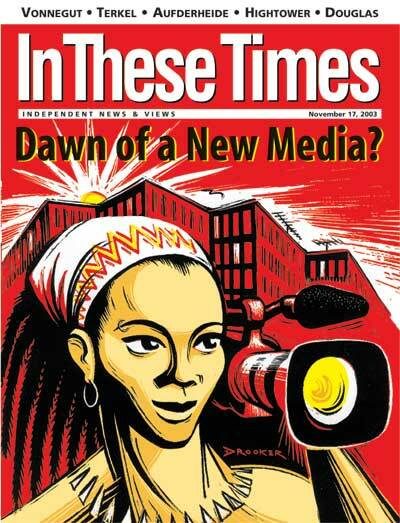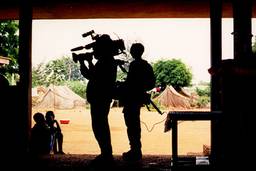
It’s bad weather in the communications industry, and not just for progressive media makers. These days, most media people, even the big guys, feel buffeted by unpredictable and rapidly changing forces.
The tempestuous conditions are now decades old, and concentration of ownership in media is just one of the troubling features.
The media industry weather has been changing so fast, so unpredictably and so unrelentingly, in part, because of the astounding implications of digital technology and the Internet. Never before have we had the capacity to make and distribute all kinds of media so easily to so many.
The weather also has been changing rapidly because of the unfolding implications of satellite technology, which vastly reduced the cost of transmitting of everything from newspaper pages to wrestling matches. Satellites transformed the cable industry and are now transforming radio. And it has been changing because Federal Communications Commission regulators permitted many more TV and radio channels, and more phone and Internet services, even as they permitted owners to control more media in any given market.
For progressives, there are inspiring examples of how to take advantage of these new possibilities. Some uses spring up out of the moment. The online activist project MoveOn.org is certainly one good example, and so are the many ad hoc efforts of people worldwide to add left perspectives to debate over the Iraq war (check out www.centerforsocialmedia.org’s “War Beyond the Box” for some funny and some sad examples).
And then there are planned-growth projects. Look at www.oneworld.net—part journalism, part belief network, part public service. It calls itself “a network of people and groups working for human rights and sustainable development from across the globe.”
Each of OneWorld’s more than 1,500 affiliate nonprofit organizations is part of an international network they can draw on for trusted help and advice. The members also can contribute information to 12 offices that run Web sites worldwide. Professional editors at those offices digest partners’ information and turn it into usable news that feeds a daily service; the editors also train partners in journalistic standards and technical procedures. OneWorld is now one of Yahoo’s top four choices for world news, and is highly regarded at the United Nations.
The project also is pioneering software that permits interactive video, or “open documentaries.” Films and videos about HIV/AIDS, climate change, Israel and Palestine, and other topics are excerpted into a sequence of one-minute bites. Viewers who have made or want to quote a video comment can easily insert an up-to-one minute segment anywhere along the thread. The software is simple enough for amateurs and easy for even antiquated computers to access. Thousands of organizations, from dozens of countries, have joined OneWorld’s online TV community since its launch in 2002. A television editor both facilitates and moderates the site.
WITNESS, launched in 1992 and based in New York, offers another fascinating example of how to creatively use new technology opportunities. With co-founder Peter Gabriel’s continuing support, WITNESS distributes cameras and offers training in production, advocacy and the post-production process to its hundred-plus partners in dozens of countries. WITNESS partner videos have been used in international human rights tribunals and in presentations to U.N. human rights bodies, on such issues as disappearances in India and mass expulsions of Haitians from the Dominican Republic. They also have been used in advocacy, public education, TV broadcast and on the Web.
The group’s Web site (www.witness.org), where visitors can watch streamed video and connect to actions for human rights, gets more than half a million hits each month. Visitors who took action after they watched a vivid short video, Forgotten People, shot by WITNESS partner Mental Disability Rights International, helped change treatment of the mentally ill in Mexico. The WITNESS video, Operation Fine Girl—about rape as a war crime in Sierra Leone—is now being used to train police and lawyers there. And when Filipino peasants filmed the death of two of their members by landlord-paid thugs, the video was used to raise public concern that forced the government to investigate the crime.
These projects are as much about building community as they are about distributing information. They are part public service and part neighborhood center. They take advantage of the power of networking, and they create a zone from which visitors get trusted information.
In adopting this strategy, they’re not alone. The big challenge for all media these days is finding users—the problem that didn’t exist for almost half a century for anyone working in network TV. Unlike the network TV model, new media projects have the ability to generate content but find it difficult to attract an audience.
All of us—especially those of us on the online side of the digital divide, but even the person with more radio stations than she can listen to—now have more media than we can possibly use, coming at us from more sources than ever before. And this requires users to do exhaustive checks to find out whether they want to trust the sending party. It’s a spam universe out there now, and media consumers are all suffering from what David Shenk calls “data smog,” a media environment polluted by untrustworthiness.
Filtering is the future. Not just the spam software filter, not just the filters that block access to porn, but filters like your personal video recorder (TIVO is one kind), which will select a TV menu for you based on earlier choices. Filters like video on demand free you from time-based TV, much less going to the video store. Filters like satellite radio liberate you from time-based radio. Filters like browser preferences allow users to treat the Internet like the buttons on their car radios. Filters like Google and Yahoo bring library-level research resources to users’ computer screens.
This prospect worries professionals of every ideological stripe, in every time-based medium, from newspapers to radio to TV. Gurus and marketers are happy to call this media diet the “Daily Me,” and they celebrate the new freedom of the consumer. But what worries the professionals should probably worry users, too.
When you have to relentlessly out-shout, out-brand and out-gimmick competitors for customer attention, when branding is a crucial shortcut to trust, advantages accrue even faster than before to those with the biggest promotional and advertising budgets (like Time Warner), those with the biggest existing reputations for quality (like the New York Times), and those with the most sensational products (like Fox). The middle ground between the biggest names and the welter of small ones is eroded.
Insiders also worry (and others should too!) that filters can be active little agenda-setters of their own. That’s why the menu services for digital TV are hot commodities right now. Control them, and media makers control channel users’ choices.
Big media are looking to control user choices in a digital-download era in other ways, too. The RIAA and MPAA calling all downloaders pirates is not just bad and stupid, it’s an irritating rearguard action much less important than other corporate moves.
The Digital Millenium Copyright Act is a vile law that criminalizes any action that breaks an owner’s anti-copying code. It goes along with industry development of digital locks in software and in hardware, so that all users in all circumstances are treated like paying customers. Such restrictions don’t just preempt fair use, a legal right of copying in place for hundreds of years. They also shut down other user rights, such as loaning your kid a CD you love or showing an article to a friend.
The digital-download era arrived with broadband Internet, the super-fast kind. The companies bringing broadband Internet to households have issues with user’s freedom of use. Most services limit upload time and amount to reduce competition with their services.
The phone and cable companies also have been slow to get broadband to customers and to make it affordable. That’s probably because they haven’t figured out quite yet how to make it pay without threatening their businesses. Meanwhile, a cheap, unregulated way to extend networks on the Internet is growing rapidly at the grassroots: wi-fi (for “wireless fidelity”), or use of open, unlicensed spectrum to connect to the Internet.
Wi-fi, where users buy their own small, radio-like sender/receivers and connect via the same kind of spectrum that baby monitors work on, could become more than a way to download e-mail at Starbucks or, as it is today, a way for rural people to get broadband when the cable company won’t string the wires.
As researchers at the New America Foundation have shown, wi-fi could become the basis for a low-cost, citizen-built, unregulated digital communications network. For this to become possible, government will have to stop giving huge wads of spectrum to assigned users like the broadcasters and start taking advantage of digital-era options that free up spectrum for flexible uses. But guess what—the current holders of spectrum and the current broadband providers aren’t wild about either of these options.
The media industry weather likely will stay stormy for a while, and that could be a good thing. Unpredictability can mean opportunity for smaller players. But the biggest players want it to calm down, and they intend to use their size and weight to influence it.
For progressive media makers, the environment creates both opportunities and agendas. Aggregating audience is a central challenge for every media outlet struggling to survive, as their potential audiences are busy filtering them out. For progressives, aggregating audience comes down to building communities of values and action, people filtering each other into their networks of values (as OneWorld, political parties and MoveOn have done) and then connecting to other networks (of allies, politicians and opinion leaders) to make change. Then the “viral marketing” so typical of digital communication can quickly expand community.
Progressive media makers also share their media problems with many others. It’s a great time to find allies to demand resources and policies that support public spaces such as public broadcasting, neighborhood communications networks and community media workshops. Those spaces aren’t left-owned or even left-leaning, but because they are public zones, progressives have a voice in them that they don’t have in commercial media.
By themselves, progressive media makers are flyspeck stakeholders in a turbulent industry environment. As defenders of public media spaces and policies, they make with others the argument that media are tools of a democratic process, an open society and a vital culture.
These very actions can affect the weather prediction by putting public voices back into the processes that shape tomorrow’s media. They also work as a shelter that keeps progressives huddling alone in the storm.
The tempestuous conditions are now decades old, and concentration of ownership in media is just one of the troubling features.
The media industry weather has been changing so fast, so unpredictably and so unrelentingly, in part, because of the astounding implications of digital technology and the Internet. Never before have we had the capacity to make and distribute all kinds of media so easily to so many.
The weather also has been changing rapidly because of the unfolding implications of satellite technology, which vastly reduced the cost of transmitting of everything from newspaper pages to wrestling matches. Satellites transformed the cable industry and are now transforming radio. And it has been changing because Federal Communications Commission regulators permitted many more TV and radio channels, and more phone and Internet services, even as they permitted owners to control more media in any given market.
Pioneering projects
For progressives, there are inspiring examples of how to take advantage of these new possibilities. Some uses spring up out of the moment. The online activist project MoveOn.org is certainly one good example, and so are the many ad hoc efforts of people worldwide to add left perspectives to debate over the Iraq war (check out www.centerforsocialmedia.org’s “War Beyond the Box” for some funny and some sad examples).
And then there are planned-growth projects. Look at www.oneworld.net—part journalism, part belief network, part public service. It calls itself “a network of people and groups working for human rights and sustainable development from across the globe.”
Each of OneWorld’s more than 1,500 affiliate nonprofit organizations is part of an international network they can draw on for trusted help and advice. The members also can contribute information to 12 offices that run Web sites worldwide. Professional editors at those offices digest partners’ information and turn it into usable news that feeds a daily service; the editors also train partners in journalistic standards and technical procedures. OneWorld is now one of Yahoo’s top four choices for world news, and is highly regarded at the United Nations.
The project also is pioneering software that permits interactive video, or “open documentaries.” Films and videos about HIV/AIDS, climate change, Israel and Palestine, and other topics are excerpted into a sequence of one-minute bites. Viewers who have made or want to quote a video comment can easily insert an up-to-one minute segment anywhere along the thread. The software is simple enough for amateurs and easy for even antiquated computers to access. Thousands of organizations, from dozens of countries, have joined OneWorld’s online TV community since its launch in 2002. A television editor both facilitates and moderates the site.
WITNESS, launched in 1992 and based in New York, offers another fascinating example of how to creatively use new technology opportunities. With co-founder Peter Gabriel’s continuing support, WITNESS distributes cameras and offers training in production, advocacy and the post-production process to its hundred-plus partners in dozens of countries. WITNESS partner videos have been used in international human rights tribunals and in presentations to U.N. human rights bodies, on such issues as disappearances in India and mass expulsions of Haitians from the Dominican Republic. They also have been used in advocacy, public education, TV broadcast and on the Web.
The group’s Web site (www.witness.org), where visitors can watch streamed video and connect to actions for human rights, gets more than half a million hits each month. Visitors who took action after they watched a vivid short video, Forgotten People, shot by WITNESS partner Mental Disability Rights International, helped change treatment of the mentally ill in Mexico. The WITNESS video, Operation Fine Girl—about rape as a war crime in Sierra Leone—is now being used to train police and lawyers there. And when Filipino peasants filmed the death of two of their members by landlord-paid thugs, the video was used to raise public concern that forced the government to investigate the crime.
These projects are as much about building community as they are about distributing information. They are part public service and part neighborhood center. They take advantage of the power of networking, and they create a zone from which visitors get trusted information.
Reaching the audience
In adopting this strategy, they’re not alone. The big challenge for all media these days is finding users—the problem that didn’t exist for almost half a century for anyone working in network TV. Unlike the network TV model, new media projects have the ability to generate content but find it difficult to attract an audience.
All of us—especially those of us on the online side of the digital divide, but even the person with more radio stations than she can listen to—now have more media than we can possibly use, coming at us from more sources than ever before. And this requires users to do exhaustive checks to find out whether they want to trust the sending party. It’s a spam universe out there now, and media consumers are all suffering from what David Shenk calls “data smog,” a media environment polluted by untrustworthiness.
Filtering is the future. Not just the spam software filter, not just the filters that block access to porn, but filters like your personal video recorder (TIVO is one kind), which will select a TV menu for you based on earlier choices. Filters like video on demand free you from time-based TV, much less going to the video store. Filters like satellite radio liberate you from time-based radio. Filters like browser preferences allow users to treat the Internet like the buttons on their car radios. Filters like Google and Yahoo bring library-level research resources to users’ computer screens.
This prospect worries professionals of every ideological stripe, in every time-based medium, from newspapers to radio to TV. Gurus and marketers are happy to call this media diet the “Daily Me,” and they celebrate the new freedom of the consumer. But what worries the professionals should probably worry users, too.
When you have to relentlessly out-shout, out-brand and out-gimmick competitors for customer attention, when branding is a crucial shortcut to trust, advantages accrue even faster than before to those with the biggest promotional and advertising budgets (like Time Warner), those with the biggest existing reputations for quality (like the New York Times), and those with the most sensational products (like Fox). The middle ground between the biggest names and the welter of small ones is eroded.
Insiders also worry (and others should too!) that filters can be active little agenda-setters of their own. That’s why the menu services for digital TV are hot commodities right now. Control them, and media makers control channel users’ choices.
Big media are looking to control user choices in a digital-download era in other ways, too. The RIAA and MPAA calling all downloaders pirates is not just bad and stupid, it’s an irritating rearguard action much less important than other corporate moves.
The Digital Millenium Copyright Act is a vile law that criminalizes any action that breaks an owner’s anti-copying code. It goes along with industry development of digital locks in software and in hardware, so that all users in all circumstances are treated like paying customers. Such restrictions don’t just preempt fair use, a legal right of copying in place for hundreds of years. They also shut down other user rights, such as loaning your kid a CD you love or showing an article to a friend.
Fighting for bandwith
The digital-download era arrived with broadband Internet, the super-fast kind. The companies bringing broadband Internet to households have issues with user’s freedom of use. Most services limit upload time and amount to reduce competition with their services.
The phone and cable companies also have been slow to get broadband to customers and to make it affordable. That’s probably because they haven’t figured out quite yet how to make it pay without threatening their businesses. Meanwhile, a cheap, unregulated way to extend networks on the Internet is growing rapidly at the grassroots: wi-fi (for “wireless fidelity”), or use of open, unlicensed spectrum to connect to the Internet.
Wi-fi, where users buy their own small, radio-like sender/receivers and connect via the same kind of spectrum that baby monitors work on, could become more than a way to download e-mail at Starbucks or, as it is today, a way for rural people to get broadband when the cable company won’t string the wires.
As researchers at the New America Foundation have shown, wi-fi could become the basis for a low-cost, citizen-built, unregulated digital communications network. For this to become possible, government will have to stop giving huge wads of spectrum to assigned users like the broadcasters and start taking advantage of digital-era options that free up spectrum for flexible uses. But guess what—the current holders of spectrum and the current broadband providers aren’t wild about either of these options.
The media industry weather likely will stay stormy for a while, and that could be a good thing. Unpredictability can mean opportunity for smaller players. But the biggest players want it to calm down, and they intend to use their size and weight to influence it.
For progressive media makers, the environment creates both opportunities and agendas. Aggregating audience is a central challenge for every media outlet struggling to survive, as their potential audiences are busy filtering them out. For progressives, aggregating audience comes down to building communities of values and action, people filtering each other into their networks of values (as OneWorld, political parties and MoveOn have done) and then connecting to other networks (of allies, politicians and opinion leaders) to make change. Then the “viral marketing” so typical of digital communication can quickly expand community.
Progressive media makers also share their media problems with many others. It’s a great time to find allies to demand resources and policies that support public spaces such as public broadcasting, neighborhood communications networks and community media workshops. Those spaces aren’t left-owned or even left-leaning, but because they are public zones, progressives have a voice in them that they don’t have in commercial media.
By themselves, progressive media makers are flyspeck stakeholders in a turbulent industry environment. As defenders of public media spaces and policies, they make with others the argument that media are tools of a democratic process, an open society and a vital culture.
These very actions can affect the weather prediction by putting public voices back into the processes that shape tomorrow’s media. They also work as a shelter that keeps progressives huddling alone in the storm.
Patricia Aufderheide, a professor in the School of Communication at American University in Washington, was culture editor of In These Times from 1978 to 1986. Now a senior editor of the magazine, her most recent book is Reclaiming Fair Use: How to Put Balance Back in Copyright, co-authored with Peter Jaszi.









